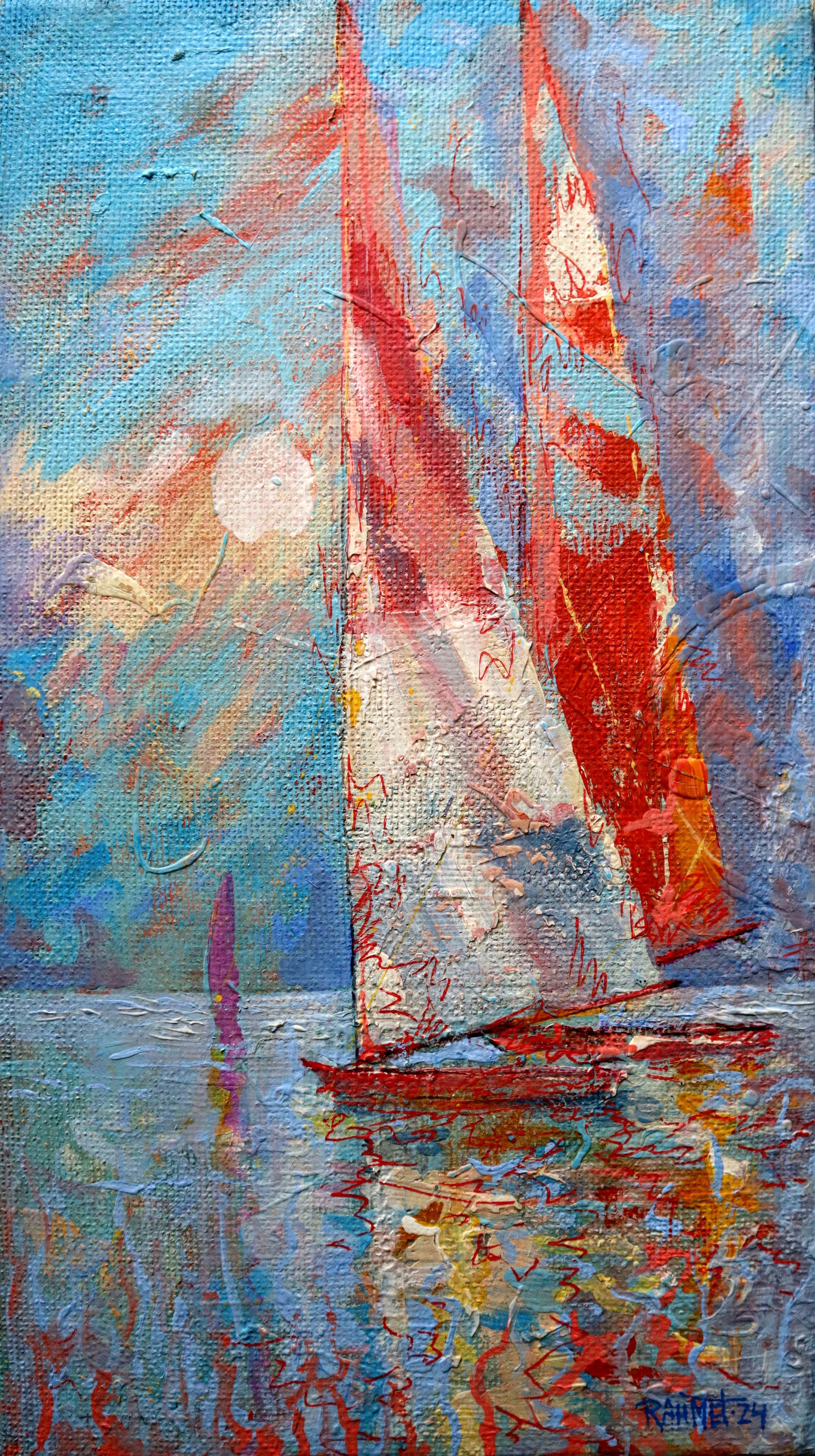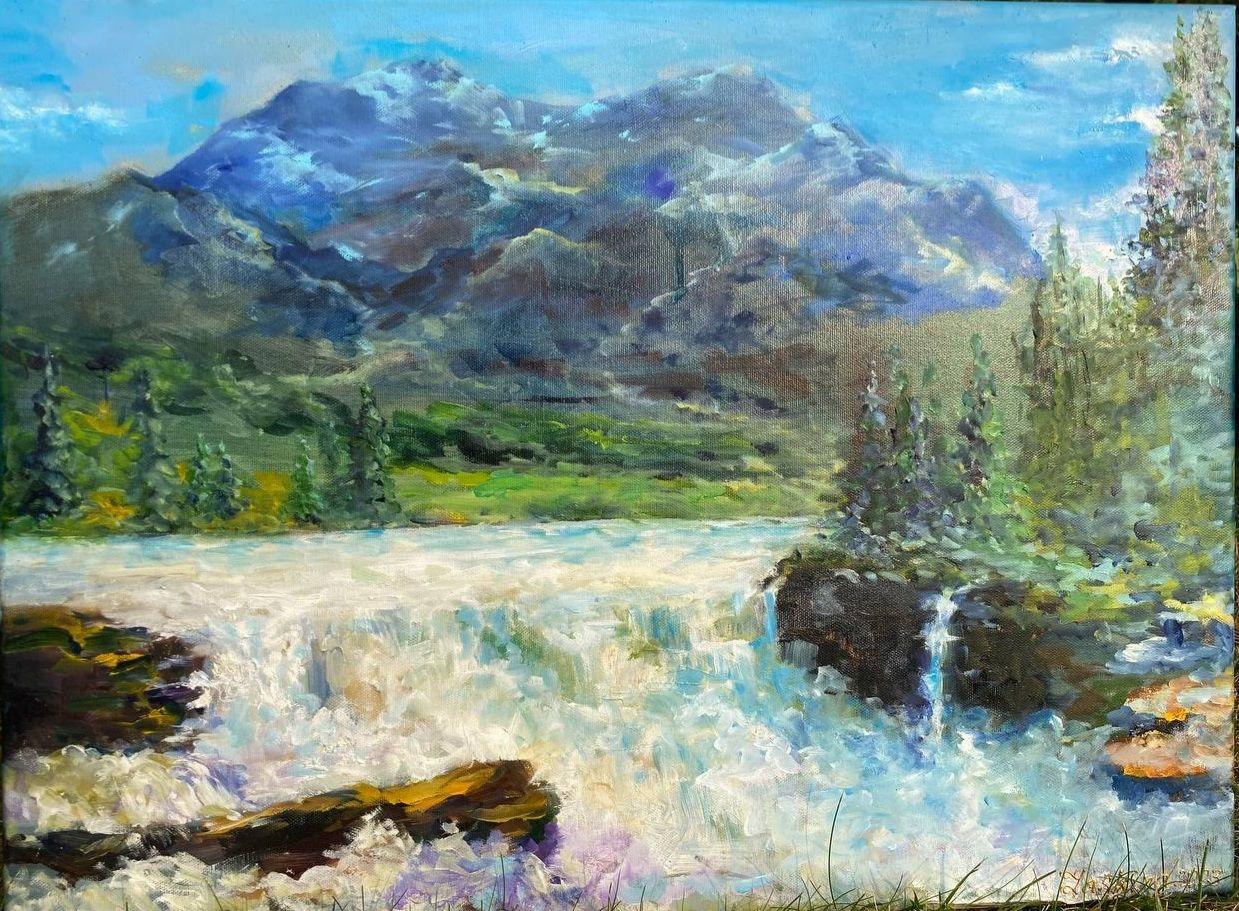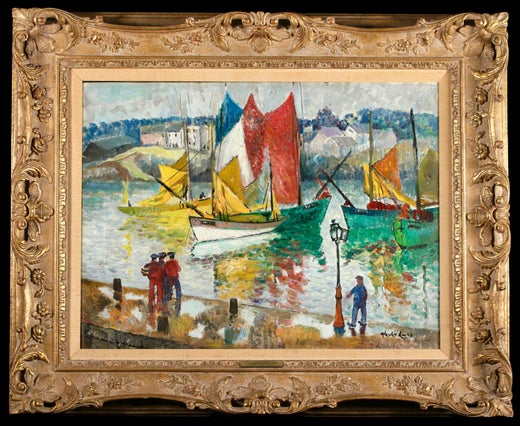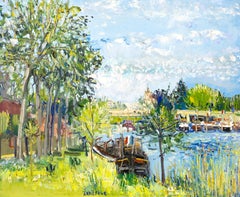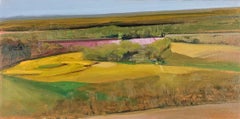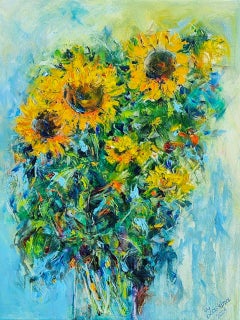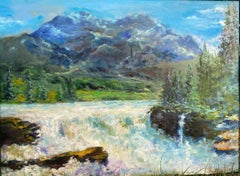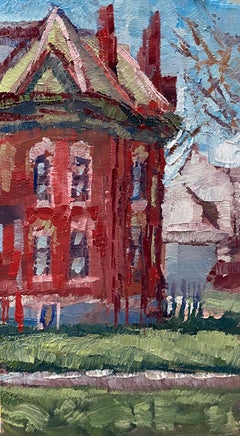Items Similar to Fishing Pier - St. Ives, Cornwall
Want more images or videos?
Request additional images or videos from the seller
1 of 8
Richard Hayley LeverFishing Pier - St. Ives, Cornwall
About the Item
Richard Hayley Lever (1876 - 1958)
"Fishing Pier - St. Ives, Cornwall
Oil on Canvas
Canvas: approx 6 1/3 x 9 1/3 inches
Framed Size: approx. 11 x 14 inches
Born in Adelaide, Australia, Hayley Lever was known for his town-shore landscapes and still-life painting in a style that combined impressionism with vivid colors and strong lines of realism---post impressionism. In his use of color, he was deeply influenced by Vincent Van Gogh. He freely explored numerous styles based on impressionism but was never locked into any particular style.
He showed early art talent and traveled to England in 1893. He studied art in London and then painted at an artists' colony in Cornwall on the seacoast of St. Ives where he began his seacoast paintings. He received much attention in Europe for these works. In 1908, he did a series of paintings called "Van Gogh's Hospital, Holland" expressing the profound influence he felt of that artist.
Lever came to America in 1911, encouraged by American artist Ernest Lawson whom he knew in France, and was soon counted among the most widely exhibited artists in New York City. Many of his scenes were of Manhattan. He had a summer studio in Gloucester, Massachusetts and from 1919 to 1931 taught at the Art Students League in New York City. He also became Director of the Studio Art Club in Mount Vernon, New York.
Lever imparted to his students the following message: "Art is the re-creation of mood in line, form and color. If I were confined to my own back yard for the rest of my life, I'd still have more pictures in my mind than I would have time to paint. Art is nothing but having a good time" (Comenos Fine Art).
He died in Mount Vernon, New York in 1958, having suffered ill health the last few years of his life.
He received many awards and critical acclaim and his works were purchased by major American museums, such as New York's Metropolitan Museum of Art and Washington's Phillips Collection and Corcoran Museum.
Source:
Michael David Zellman, "Three Hundred Years of American Art"
- Creator:Richard Hayley Lever (1876-1958, American)
- Dimensions:Height: 11 in (27.94 cm)Width: 14 in (35.56 cm)Depth: 1 in (2.54 cm)
- Medium:
- Movement & Style:
- Period:
- Condition:
- Gallery Location:Missouri, MO
- Reference Number:1stDibs: LU74734986931
Richard Hayley Lever
An Australian by birth, Richard Hayley Lever left his native Adelaide at the age of 17 to train as an artist in Europe, and his work soon won attention in London and Paris. In 1900 he was introduced to the St Ives Club by fellow Australian Louis Grier, and he married Aida Gale in the town in the same year. Working closely with Grier and with Julius Olsson he maintained St Ives as a base, while also painting marine subjects along the southern coast of England and in Brittany. In 1912 Hayley Lever move to New York and took American citizenship. His paintings of the Hudson Valley, Vermont, and Nantucket secured an international reputation.
About the Seller
5.0
Vetted Professional Seller
Every seller passes strict standards for authenticity and reliability
Established in 1970
1stDibs seller since 2017
153 sales on 1stDibs
Typical response time: 17 hours
- ShippingRetrieving quote...Shipping from: Missouri, MO
- Return Policy
Authenticity Guarantee
In the unlikely event there’s an issue with an item’s authenticity, contact us within 1 year for a full refund. DetailsMoney-Back Guarantee
If your item is not as described, is damaged in transit, or does not arrive, contact us within 7 days for a full refund. Details24-Hour Cancellation
You have a 24-hour grace period in which to reconsider your purchase, with no questions asked.Vetted Professional Sellers
Our world-class sellers must adhere to strict standards for service and quality, maintaining the integrity of our listings.Price-Match Guarantee
If you find that a seller listed the same item for a lower price elsewhere, we’ll match it.Trusted Global Delivery
Our best-in-class carrier network provides specialized shipping options worldwide, including custom delivery.More From This Seller
View AllBateau Sous la Pont
By Yolande Ardissone
Located in Missouri, MO
Bateau Sous la Pont
Yolande Ardissone (French, b. 1927)
Oil on Canvas
Signed Lower Center
30.25 x 25.25
31.5 x 36.5 inches with frame
Born in Normandy on June 6, 1927 to an Italian ...
Category
Late 20th Century Impressionist Landscape Paintings
Materials
Canvas, Oil
Price Upon Request
Avenue des Champs-Elysses, Paris
By Antoine Blanchard
Located in Missouri, MO
Antoine Blanchard (French 1910-1988)
"Avenue des Champs-Elysses, Paris"
Oil on Canvas
Signed
approx 18 x 22 (site)
approx 26.5 x 30 (framed)
Antoine Blanchard (c.1910-1988) was a prolific and successful Neo-Impressionist painter who specialized in nostalgic scenes of Fin de Siècle Paris. Inspired by the subjects as well as the success of earlier painters of Parisian life like E. Galien Laloue (1854-1941), Edouard Cortès (1882-1969), Jean Béraud (1849-1935) and Luigi Loir (1845-1916), Blanchard painted hundreds of views of the “City of Light.” In the late 1950s, his street scenes were exported to the United States and the United Kingdom, where they were sold briskly to collectors. By the1960s, Blanchard paintings were bringing several hundred dollars in galleries, so while they were not inexpensive, they were affordable to collectors who loved Parisian scenes but who could not afford the works of Cortes or one of the other French painters known for their views of Paris in Belle Époque. Eventually Blanchard’s more delicate, feathery pastel-toned scenes of rain-swept Paris became sought after in their own right and, when he died, he was considered the last of what the dealers described as the École de Paris or “School of Paris” painters.
The most salient fact about the life and career of the painter Antoine Blanchard was that he was actually born Marcel Masson, the son of a furniture maker who lived in the scenic Loire Valley, south of Paris, where the French nobility had their chateaus. The date that is usually given for Blanchard’s birth is November 15, 1910. However, there has been some speculation that he was born even later, perhaps in 1918, but some of the facts of his life have always been clouded by early biographies that claimed even earlier dates for his birth, so that he would seem to be seen as a contemporary of the famous Belle Époque painters rather than a post-war interpreter of Paris.
Blanchard grew up in the hardscrabble years following the First World War. Because he was artistically talented, he was sent first to the nearby city of Blois, the capital of the Loir-et-Cher Département, for artistic training and then to the École des Beaux-Arts in Rennes, on the Brittany peninsula, where he received a classical art education. By some accounts Blanchard also studied in Paris, where the historic École des Beaux-Arts is located, but the depth of his study and the style of his earliest work will require further research.
Marcel Masson was married in 1939, as war clouds gathered on the French horizon. He was drafted for service in the French Army and participated in the short and futile struggle against the invading German Panzers before returning to his family and his art during the Nazi occupation. A daughter, Nicole, was born in 1944 with a second daughter, Eveline, who eventually came to the United States, following in 1946.
Masson’s early art career was interrupted, first by World War II and later by the necessity of keeping his father’s workshop running in the years after his death. By the late 1940s, though, Masson returned to his art and moved to Paris in order to further his career.
Exactly when Marcel Masson adopted the pseudonym Antoine Blanchard is not known, nor are we aware of his motivations for adopting a nom de plume, but the practice was not unusual for French painters. In most cases a pseudonym was adopted because the artist had contractual obligations with more than one agent or dealer. Another motivation could be to obscure the scope of a sizable artistic production. Dealers in that era also liked to keep an artist under their thumb, so a pseudonym was a way for Blanchard’s dealers to tuck him away, out of the sight of their competitors.
Like many painters before him Masson may have initially painted different subjects under different names. Marcel Masson neé Blanchard would have been well aware that the famous and prolific French painter E. Galien Laloue (1854-1941) painted under no less than four names – three pseudonyms in addition to name he was christened with – and so the adoption of another name was probably not seen as a liability to him.
However, he apparently never took the step to register his pseudonym, which was possible in France, to legally restrict its use. In any event, by the 1950s Marcel Masson had become “Antoine Blanchard,” a painter of Parisian views. With the aging Edouard Cortès (1882-1969) as a model, Blanchard began to specialize in romanticized scenes of la ville des lumières, or the “City of Light.”
However, instead of painting contemporary Paris, the crowded metropolis of his own time, which he may have felt was lacking in romance, he chose to look at the French capital through the rear-view mirror. So Blanchard became known for his depictions of the hurly-burly life of Paris in the Belle Époque. For inspiration, he is said to have collected old sepia-toned postcards of life in La Belle Époque (“The Beautiul Era”), the long period of peace and relative prosperity between the end of the Franco-Prussian War and the horrors of the Paris Commune in 1871 and the start of the mass bloodshed of the First World War in August of 1914. In addition, however, the paintings of Loir, Baraud, Laloue and Cortès could be found and studied in the flea markets of Paris as well as the auctions at the l’Hôtel Drouot.
Reminders of the Belle Epoch were thus all around Blanchard, and of course the architecture that he painted had survived the Second World War intact, because Paris was spared bombing or a siege by the allies. Soon he was painting the horse-drawn omnibuses that took turn-of-the-century Parisians on longer trips throughout the city as well as the tradesmen, children and fashionably dressed ladies that populated Baron Haussmann’s Grand Boulevards.
Blanchard’s early work was clearly modeled after the paintings of Edouard Cortès, but he was always his own man and never a slavish copyist. These paintings were darker in palette than the later Blanchard paintings most American collectors have become familiar with, and his red and blue tones were often bolder than those of Cortès. He never adopted the heavy “impasto,” the build-up of paint on the highlights of Cortes’ work, leaving that artistic trademark to the master. Blanchard’s brushwork was painterly, but the buildings in the paintings were always well rendered, for he had an excellent command of composition and perspective.
By the late 1950s, agents began to purchase Blanchard’s paintings and then to export them to the United States, selling them to commercial galleries in far away Houston, Los Angeles, San Francisco, Chicago and New York. By the early 1960s, his work was already well known enough to be in reproduced by print publishers and the Donald Art Company published a number of popular prints that are now often mistaken for original paintings. By the end of the 1960s, Blanchard had begun to develop his own mature style by employing a lighter, brighter, palette and a deft, almost calligraphic style of brushwork. This helped him step out of Cortès’ shadow and become a sought-after painter in his own right. Blanchard worked through agents, essentially brokers, who purchased his work and created a demand for it in the United States and Canada.
By the 1970s Blanchard’s paintings were being sold by galleries across the United States, and the American market absorbed virtually all of his work. In 1969, with the passing of Edouard Cortès, he became the last of the long series of prolific French painters of Parisian life. Blanchard’s later works were usually daylight scenes, with Paris seen awash in rain or with a mantle of soft snow, and so collectors no longer confused him with Cortes, whose Parisian clock seemed to always be set at twilight. These paintings were rendered in softer, pastel tones and he used his brush with a light touch. These qualities gave Blanchard’s work of the 1970s and 1980s a lighter, more decorative appearance.
In the late 1970s, the French agent Paul Larde published a lavish book that was claimed to be an authorized biography of Antoine Blanchard by his “exclusive” dealer. Today, this book is almost impossible to find, because it was apparently the subject of a lawsuit in France. Some of the information in the Larde book was contested and found to be inaccurate and so it was withdrawn from publication.
One claim that Larde made was that Blanchard’s production was extremely limited. While he was not as prolific as Cortès or Laloue, he was a hard-working painter who managed to supply a long list of galleries with his work. He produced thousands of paintings during his career. When the motivation for a monograph is marketing rather than art history, accuracy and detail can be swept aside by exaggeration, hyperbole and claims of exclusivity that were meant to discourage collectors or galleries from buying Blanchard’s from other representatives. Blanchard’s legitimate paintings were sold by several agents, who dealt directly with the artist, at least one of whom was American, one Austrian and a few French dealers.
The details of Antoine Blanchard’s life are not well known because he never sought the limelight. He was content to work in his studio and ship his paintings to his agents who sold them abroad. Eventually both his daughters – Nicole and Evelyn – followed in his footsteps and became painters themselves. Evelyn (1946-2008) was savvy enough to adopt the Blanchard nom de plume, and she began painting street scenes that closely resembled her father’s later work.
Antoine Blanchard passed away in 1988, leaving hundreds of paintings of Belle Époque Paris– the Notre Dame Cathedral, the Opera, the Arc de Triomphe and Place Concorde – as his lasting legacy.
Notes on the Authentication of Antoine Blanchard’s Paintings:
The vast majority of Blanchard’s paintings were smaller works, which were sent to the United States in tubes and stretched and framed by the galleries that sold them. Virtually all of these Blanchards were painted in European centimeter sizes, which convert to 13” x 18” or 18” x 21 1/2?, but on very rare occasions he painted much larger works in American sizes – such as 24” x 36” – on commission for dealers such as Howard Morseburg in Los Angeles or the dapper Wally Findlay, who had a chain of galleries. The first way to assess the authenticity of a Blanchard...
Category
Mid-20th Century Impressionist Landscape Paintings
Materials
Canvas, Oil
Price Upon Request
Boulevard de la Madaleine sous la Neige
By Antoine Blanchard
Located in Missouri, MO
Antoine Blanchard
"Boulevard de la Madeleine sous la Neige"
Oil on Canvas
Signed
Canvas Size: 13 x 18 inches
Framed Size: approx 18 x 23 inches
Antoine Blanchard
French (1910-1988)
Category
Mid-20th Century Impressionist Landscape Paintings
Materials
Canvas, Oil
Price Upon Request
Homestead
By Joan Parker
Located in Missouri, MO
Joan Parker (20th C.)
"Homestead"
Oil on Canvas
11 x 14 inches
13 x 16 framed
Joan Parker, is a Plein Air landscape painter and a native of California. Her artistic abilities were...
Category
21st Century and Contemporary American Impressionist Landscape Paintings
Materials
Canvas, Oil
$2,300
Gray Brothers
By Charles Harold Davis
Located in Missouri, MO
Charles Harold Davis (1856-1933)
"Gray Brothers"
Oil on Canvas
Signed Lower Left
Canvas Size: 30 x 24 inches
Framed Size: 35 x 30.5 inches
Born in Amesbury, Massachusetts, Charles ...
Category
Late 19th Century American Impressionist Landscape Paintings
Materials
Oil, Canvas
Price Upon Request
A Place in the Sun
By Carl Ivar Gilbert
Located in Missouri, MO
Carl Iver Gilbert (1882-1959)
"A Place in the Sun"
Oil on Canvas
Signed
Image: 10 x 12 inches
Framed Size: 15 x 18.5 inches
Carl Ivar Gilbert was a...
Category
Mid-20th Century American Impressionist Figurative Paintings
Materials
Canvas, Oil
Price Upon Request
You May Also Like
Two Sails
Located in Zofingen, AG
In this dance of acrylic and oil, I've harnessed expressionism and impressionism to capture the fleeting essence of tranquility and motion. Through vibrant hues and bold strokes, I'v...
Category
2010s Impressionist Interior Paintings
Materials
Canvas, Oil, Acrylic
"Ukrainian flowers"
Located in Edinburgh, GB
Sunflower is a symbol of Ukraine. This incredibly bright flower is a sign of the sun. It brings people strength and well-being, is considered the embodiment of solar energy, good lif...
Category
21st Century and Contemporary Impressionist Landscape Paintings
Materials
Canvas, Oil
"Athabasca fall"
Located in Edinburgh, GB
Canada boasts an abundance and variety of natural wonders such as lakes, mountains and rivers. It is also home to some of the most stunning waterfalls in the world. This waterfall is...
Category
21st Century and Contemporary Impressionist Landscape Paintings
Materials
Canvas, Oil
"Historic Gebhard Mansion" (2024) by Delton Demarest, Original Oil Painting
Located in Denver, CO
Delton Demarest's "Historic Gebhard Mansion" (2024) is an original oil painting on panel painted on location en plein air, measuring 6 x 3.25 x 0.25 inches. This artwork captures the...
Category
21st Century and Contemporary Impressionist Figurative Paintings
Materials
Canvas, Oil
Autumn Palette, Landscape Impressionism Original oil Painting, Ready to Hang
By Vahe Yeremyan
Located in Granada Hills, CA
Landscape Impressionism Original oil Painting, Ready to Hang
Artist: Vahe Yeremyan
Work: Original Oil Painting, Handmade Artwork, One of a Kind
Medium: Oil on Canvas
Year: 2024
St...
Category
2010s Impressionist Landscape Paintings
Materials
Canvas, Oil
Aspen, Contemporary Art, Original oil Painting, Ready to Hang
By Vahe Yeremyan
Located in Granada Hills, CA
Artist: Vahe Yeremyan
Work: Original Oil Painting, Handmade Artwork, One of a Kind
Medium: Oil on Canvas
Year: 2024
Style: Contemporary Art,
Title: Aspen,
Size: 43.5" x 37" x 1''...
Category
2010s Impressionist Landscape Paintings
Materials
Canvas, Oil
$5,600 Sale Price
20% Off
